TCEQ Toxicity Factors and Protection of Human Health
Questions and answers about TCEQ derived toxicity factors and how they are used to protect public health.
NEW
The TCEQ Environmental Health Update (TCEQ publication GI-450) has been posted
Air Monitoring Comparison Values (AMCVs) and Effects Screening Levels (ESLs) are screening levels for ambient air set to protect human health and welfare.
AMCVs:
- AMCV is a collective term for chemical-specific short- and long-term air concentrations used to evaluate air monitoring data.
- AMCVs are set to protect human health and welfare.
- Health-based AMCVs are safe levels at which exposure is unlikely to result in adverse health effects.
- The TCEQ long-term AMCVs are similar to the U.S. EPA’s inhalation reference concentrations.
- AMCVs are used by the TCEQ to determine if there is a potential concern, which would trigger a more in-depth review and focus of agency resources, such as in areas on the Air Pollutant Watch List (APWL). The APWL program has been particularly successful; several areas and air contaminants have been removed from the APWL in the last few years. To further promote transparency, all potential changes to the APWL are open for public comment. All state senators and representatives whose districts are in these areas are notified before any final change.
ESLs:
- ESLs are chemical-specific air concentrations set to protect human health and welfare and are used for air permitting.
- Health-based ESLs are set 70 percent lower than the safe level, or AMCV.
- This additional buffer allows the TCEQ to take into account exposure to chemicals from multiple sources in air permit reviews.
- ESLs are used to establish maximum emission rates that are written into enforceable air permits.
No!
- AMCVs and ESLs are screening levels used to evaluate air monitoring data and air permits, respectively.
- The TCEQ has developed state-of-the-science guidelines for developing toxicity factors, which have undergone scientific peer review and two rounds of public comment. We also publish our work in the peer-reviewed scientific literature.
- ESLs and AMCVs are designed to prevent adverse health effects, including but not limited to cancer, respiratory diseases, and eye and respiratory irritation for all members of the population.
- These levels and values are set sufficiently below a level expected to cause adverse health effects so that, even when concentrations of a contaminant are somewhat above the ESL or ReV, adverse health effects are not expected. Therefore, an exceedance does not necessarily mean that an adverse health effect is expected, but rather that an in-depth review is needed.
- The TCEQ guidelines follow standard scientific methods commonly used by other agencies, including the U.S. EPA, to develop up-to-date toxicity factors.
- The TCEQ guidelines were developed, in large part, in response to public demand for the most scientifically defensible screening values available.
- Differences may exist between TCEQ screening levels and comparable values from other agencies due mainly to selection of more current studies, different data sets, evaluation of different exposure durations and interpretation of dose-response data, science policy, and the analytical and statistical tools used. There may also be differences in the methods used. Different values, regardless of whether they are higher or lower, are health protective and scientifically defensible.
- Development-support documents outline the scientific basis and steps taken to develop toxicity factors. The DSDs are published on the TCEQ’s website.
- Values developed by the TCEQ are used by other states and countries—e.g., Georgia, Louisiana, Michigan, North Carolina, Wisconsin, Minnesota, Belgium, Canada (Ontario, British Columbia, and Calgary), Israel, Netherlands, Taiwan, China, Australia, and Austria.
Occasionally, when new scientific data and/or more recent methods become available, AMCVs and ESLs can change. The new values are scientifically valid and are generally more health-based. Updated values, regardless of whether they are higher or lower than the previous values, are health protective and scientifically defensible.
- The 2007 long-term screening level for benzene (1.4 ppb) was derived under the 2006 Guidelines to Develop Effects Screening Levels, Reference Values, and Unit Risk Factors (TCEQ publication RG-442, revised 2015).
- The TCEQ unit risk estimate used to develop the benzene long-term screening level falls within the range the U.S. EPA has calculated, “within which any calculated unit risk estimate would have equal scientific validity” (EPA).
- The 2007 benzene DSD underwent public comment, and documents the most recent scientifically defensible benzene values available.
- The previous long-term screening level (1 ppb) for benzene was much less scientifically based. It was derived by dividing an occupationally-acceptable level (OSHA TWA PEL of 1 ppm) by 1,000 (i.e., not through a state-of-the science dose-response assessment).
- The 2007 long-term screening level for benzene (1.4 ppb) is the product of using the TCEQ’s state-of-the-science guidelines.
1,3-Butadiene
- The 2008 long-term screening level for 1,3-butadiene (9.1 ppb) resulted from the application of the TCEQ’s state-of-the-science guidelines, as documented in the DSD (the TCEQ has also published this information in a scientific journal, Risk Analysis).
- This screening level is based on an updated epidemiological study published in 2004; that study has more accurate, validated exposure estimates with additional years of data than the 1995–96 epidemiological studies used by USEPA.
- The 1,3-butadiene DSD underwent two public comment periods and an external scientific peer review; all the peer reviewers commented that the updated 2004 study was superior to the 1995–96 studies.
- North Carolina has also used these updated data in calculating its acceptable ambient level values.
- After an extensive review, the Ontario Ministry of the Environment concluded: “Based on the inhalation unit risk estimates reported by Environment Canada/Health Canada, the US EPA, the states of North Carolina, and Texas, …The unit risk estimate of the State of Texas is considered to be the most appropriate URF since its derivation is based on an extensive risk analysis and a detailed peer review process.”
- Consistent with the MOA data available for 1,3 butadiene, the TCEQ applied an age-dependent adjustment factor to account for susceptibility of children, as well as using multiple conservative assumptions, (i.e., the use of a linear, no threshold model; use of the 95 percent upper confidence limit instead of the central tendency value; data were restricted to the lower 95% of the exposure range; etc.).
No!
Available data indicate that Texans have no more, or less, cancer and asthma than many other states, and the nation as a whole, even though Texas has more industry than any other state. (It is important to note, the environment is only one factor that may contribute to adverse health outcomes.)
According to the Surveillance, Epidemiology, and End Results Program (SEER), statewide incidence cancer rates in Texas from 2008 through 2012 were among the lowest in the United States.
Figure 1. Incidence rates for the United States, 2008–2012.
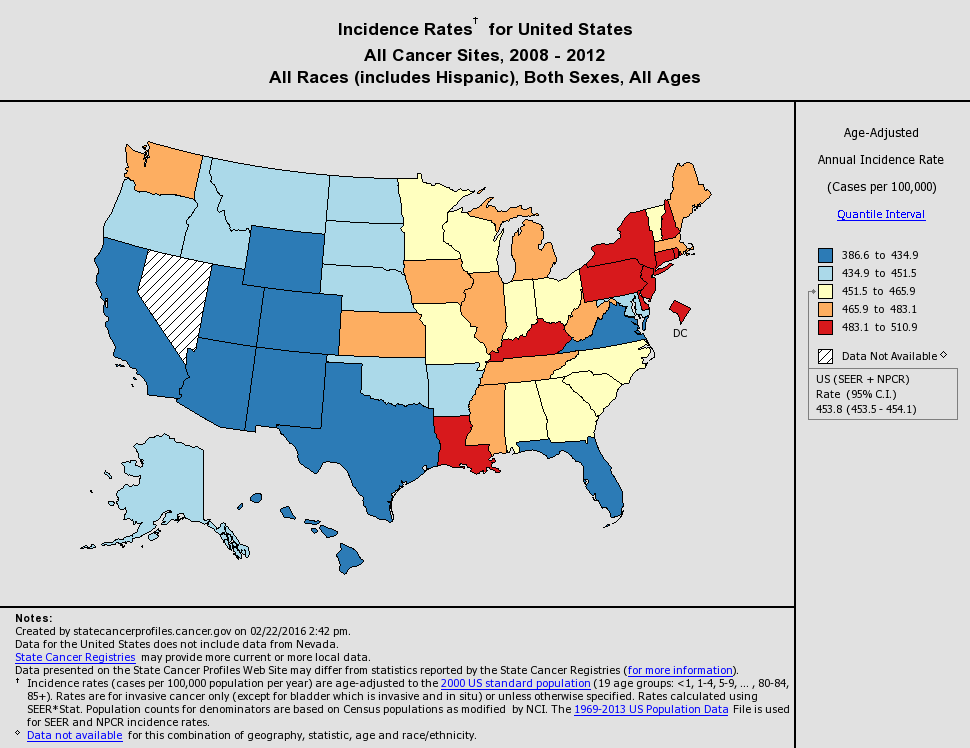
Figure 2. Age-adjusted rates per 100,000 for all cancers for 2008–2012 in the United States, California, and Texas.
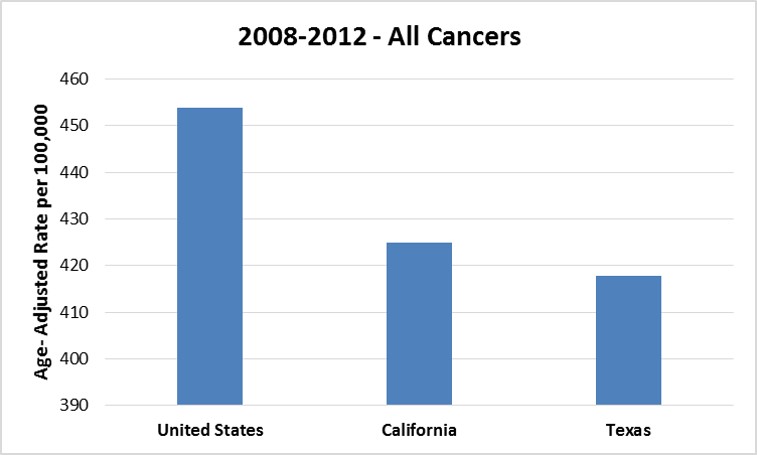
According to the Texas Cancer Registry, statewide incidence cancer rates in Texas have demonstrated a slight decreasing trend from 2007 through 2011 (the most recent rates currently available).
Figure 3. Age-adjusted rates per 100,000 for all cancers for 2008–2012 in Texas.
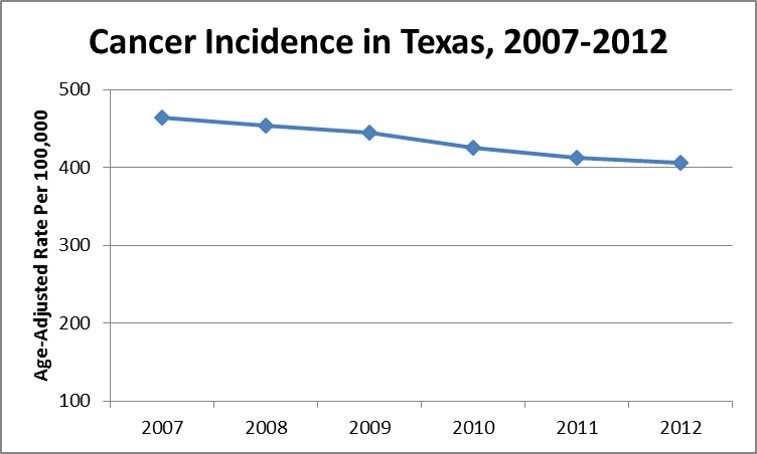
From 2007 through 2011, Texas’ combined age-adjusted rates per 100,000 for leukemia, lung and bronchial cancers (not adjusted for smoking), and non-Hodgkin’s lymphoma were similar to those of California and the overall United States.
Figure 4. Age-adjusted rates per 100,000 for leukemia, lung and bronchus and Non-Hodgkin’s lymphoma for 2008–2012 in Texas.
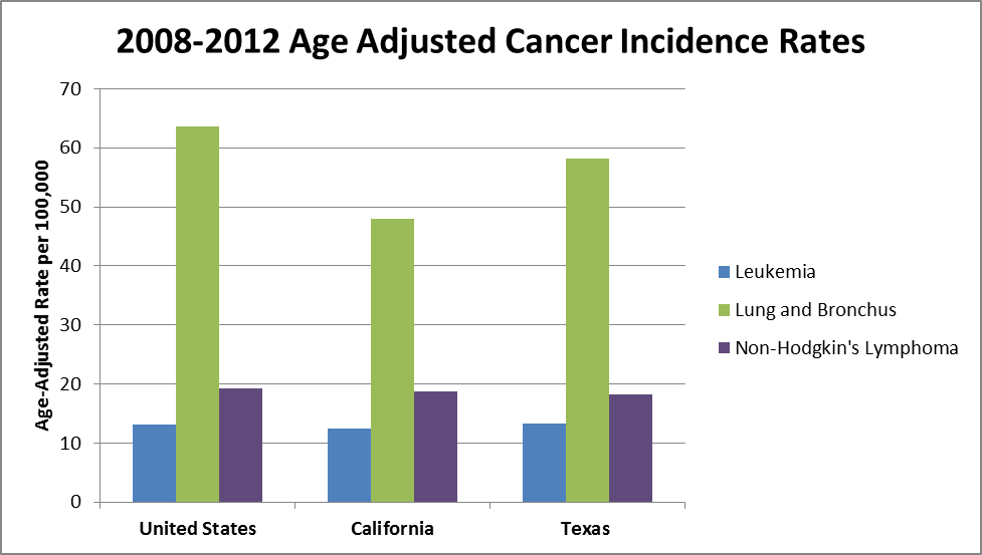
According to the Air Pollution and Respiratory Health Branch of the CDC, 2012 prevalence rates of lifetime asthma in Texas were among the lowest in the United States.
Figure 5. 2013 Adult self-reported lifetime asthma prevalence rates by state.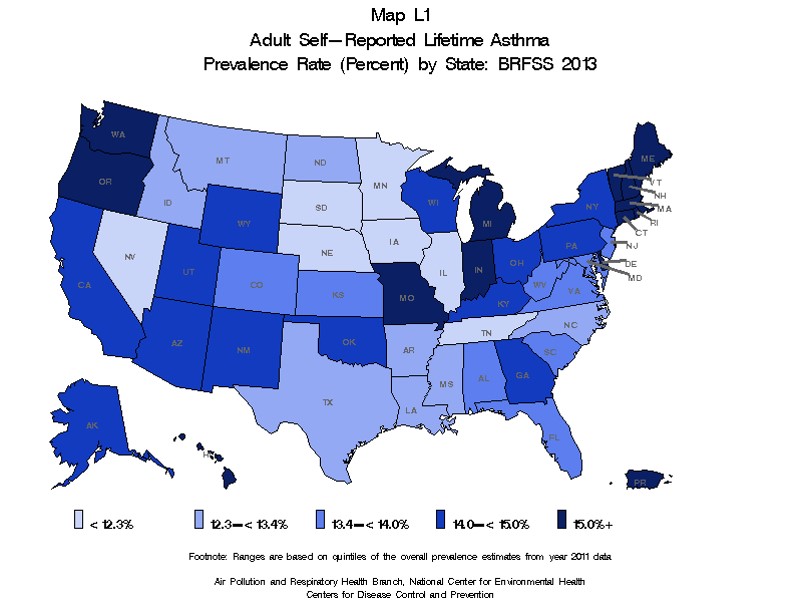
No!
Benzene
Benzene is released into the air by a variety of sources (e.g., industry, automobiles, lawn mowers, etc.), and is one of the most widely monitored air toxics due to its ability to cause cancer (e.g., in workers occupationally exposed daily to very high levels).
Since 2010, all monitors in Texas have had annual average benzene concentrations below the state’s long-term AMCV.
In 2020, all monitors in Texas had annual average benzene concentrations below the state’s long-term AMCV.
Figure 6. Average benzene concentrations at monitoring sites in Texas in 2020
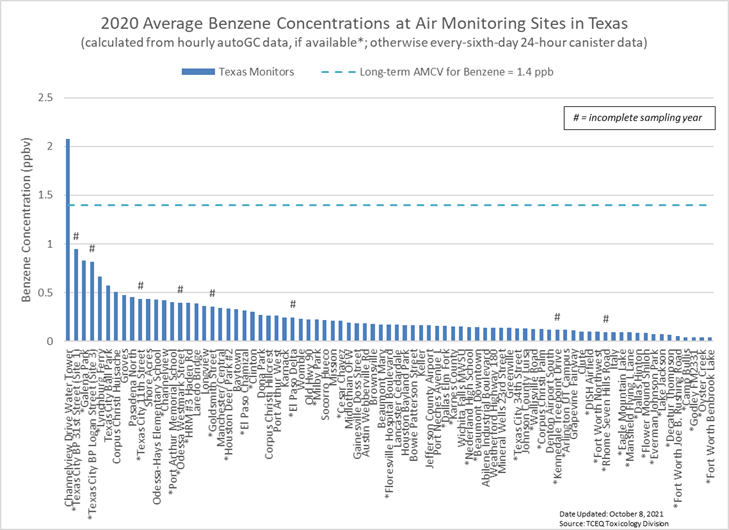
Over 90 percent of the monitors operating from 2000 through 2020 (29 total across the state) showed a decrease in annual average concentrations of benzene. In 2020, all monitors in Texas had annual average benzene concentrations below the state’s long-term AMCV.
Figure 7. Annual average benzene concentration at Texas monitoring sites active in 2000 and 2020
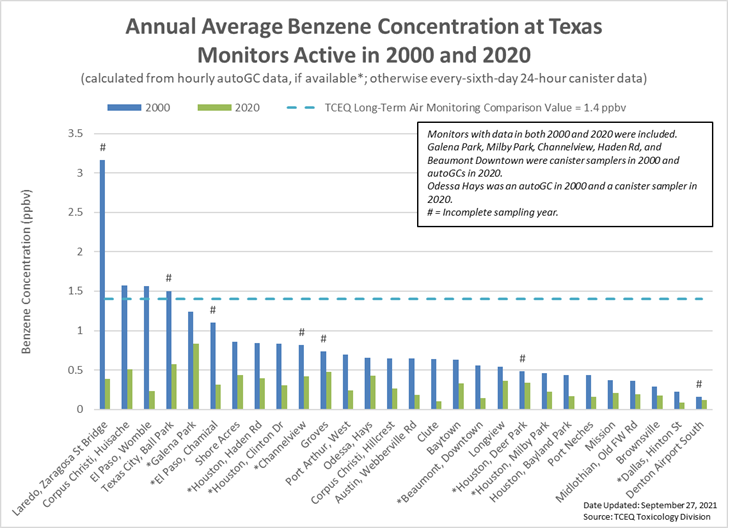
Benzene in Houston
Houston is one of the most industrialized regions in the country.
From 2000 to 2020, nearly 90 percent of the benzene monitors (10 total that were active in 2000 and 2020) in the Houston Region showed a decrease in annual average concentrations.
In 2020, all monitors in the Houston Region had annual average benzene concentrations well below the AMCV.
Figure 8. Annual average benzene concentration at Houston monitoring sites active in 2000 and 2020
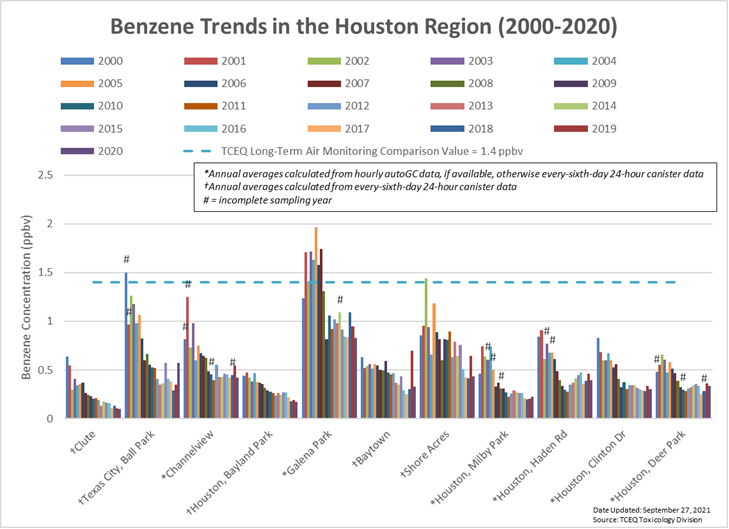
1,3-Butadiene
1,3-Butadiene is frequently considered a chemical of concern by the public.
From 2000 to 2020, nearly 76 percent of the 1,3-butadiene monitors (29 total active from 2000 to 2014) in Texas showed a decrease in annual average concentrations.
Figure 9. Annual average 1,3 butadiene concentration at Houston monitoring sites active in 2000 and 2020
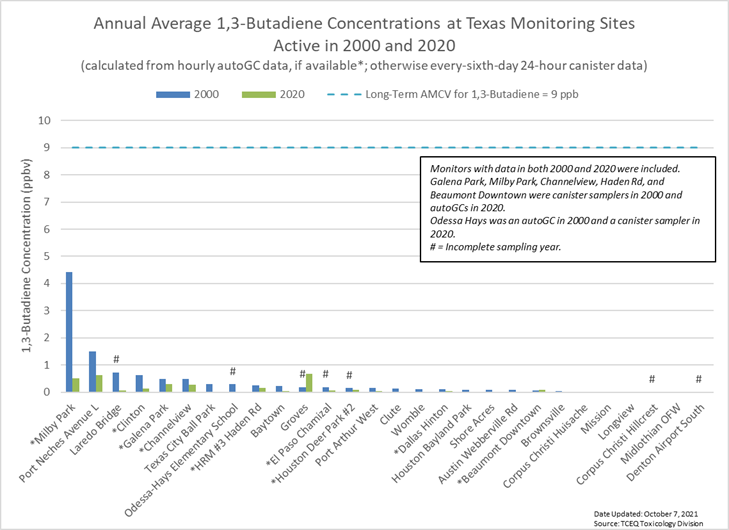
Since 2000, all monitors in Texas have consistently shown annual average 1,3-butadiene concentrations many times below the state’s long-term AMCV. Figure 9. Annual average 1,3 butadiene concentration at Houston monitoring sites active in 2000 and 2020
As new scientific data and more recent methods become available, AMCVs and ESLs may change to reflect the latest available science.
As part of this process, the public has the opportunity to submit comments on DSDs.
In addition, the TCEQ welcomes submission of data and proposed revisions from anyone. All data and proposals received by the agency are evaluated based on their scientific and technical merit. The agency may incorporate comments into DSDs that increase the scientific and technical merit of the chemical-specific AMCVs or ESLs.
The Toxicology Listserv is a TCEQ service to keep the public informed of news and changes to our programs. For example, the Listserv notifies environmental groups, academia, industry, and any other interested parties if a DSD has been posted for public comment.
Interested parties can receive e-mails when new TCEQ Toxicology-related announcements are released. To sign up to receive announcements related to the ESL List or the AMCV List, and other TCEQ Toxicology announcements, visit: https://www.tceq.texas.gov/toxicology/announcements.
Various other state and federal agencies have contacted the TCEQ to find out about our guideline levels, and have complimented our work as state of the science.
Wisconsin
DNR Report to the Natural Resources Board: Silica Study (August 2011)
“In addition to its non-cancer benchmarks, TCEQ is the only air agency in the US that has established a cancer-based health benchmark for ambient air exposures to crystalline silica.”
"Among the states surveyed, Texas has the most comprehensive approach to controlling silica emissions.”
Ontario
Ministry of the Environment Science Discussion Document on the Development of an Air Standard for 1,3-Butadiene (December 2008)
“The TCEQ has strengthened the risk assessment of the US EPA for 1,3-butadiene by incorporating new data not available to the US EPA in 2002. With support from the US EPA, the TCEQ has derived new and in-depth dose-response and statistical analyses for 1,3-butadiene.”
“Of the risk assessments and unit risk estimations conducted by these jurisdictions examined, the dose-response analyses and quantitative risk analyses conducted by the TCEQ and NCSAB are preferred over those conducted by the Environment Canada/Health Canada and the US EPA for the selection of improved exposure estimation by the former jurisdictions. The TECQ provided detailed supporting documentation for its risk analyses and unit risk derivation. The TCEQ evaluation has been intensively peer-reviewed by an independent scientific organization and provided the most up-to-date evaluation of the cancer risks from 1,3-butadiene exposures. The unit risk estimate derived by the NCSAB is in close agreement with that developed by the TCEQ and therefore lends credibility to the inhalation cancer risk estimate reported by the TCEQ.”
“Based on the inhalation unit risk estimates reported by Environment Canada/Health Canada, the US EPA, the states of North Carolina, and Texas, the risk-specific air concentrations, at an excess lifetime cancer risk of one in a million, are derived to be 0.17, 0.03, 1.28, and 2 μg/m3, respectively. The cancer risk estimates proposed by the states of Texas and North Carolina are considered appropriate for the derivation air standards for Ontario for the use of updated and more reliable exposure estimates, as compared with those used by Environment Canada/Health Canada and the US EPA. The unit risk estimate of the State of Texas is considered to be the most appropriate URF since its derivation is based on an extensive risk analysis and a detailed peer review process.”
Peer-Reviewer Comments
U.S. EPA: Methods to Develop Inhalation Cancer Risk for Chromium and Nickel Compounds
Of three independent reviewers, two suggested using the URE (unit risk estimate) derived by the TCEQ rather than the one derived by the Integrated Risk Information System (IRIS); the third author did not comment on alternative approaches
“I would recommend using the TCEQ URE of 1.7 × 10-4 μg/m3. The risk assessment leading to the derivation of this number was performed recently, included an updated and critical review of the literature, and appears to be comprehensive with an emphasis on health protection. One additional strength of the TCEQ evaluation is its inclusion of the Grimsrud et al. (2003) study where soluble nickel compounds, one of the major types found in the EGU emissions, were associated with elevated cancer incidence. It should also be noted that the TCEQ URE is quite similar to that derived by the CDHS (2.6 × 10-4 μg/m3) and the EPA for nickel refinery dust (2.4 × 10-4 μg/m3). The TCEQ, CDHS and EPA nickel refinery dust UREs could also be combined to derive a composite URE.”
“Use the TCEQ URE of 2.64-4 per μg/m3 (smoking adjusted Relative Risk Estimate with a U.S. background rate). This approach: (1) uses human data for the risk estimate, (2) takes advantage of a nickel-exposed cohort (Grimsrud 20039) for which there are data on the prevalence of smoking.”
2012 Update to TCEQ Guidelines for Developing Toxicity Factors
All responding reviewers agreed that the TCEQ guidance references the most current, valid, and generally accepted federal or state guidance documents or key papers.
“To the best of my knowledge, this guidance is complete and thorough, even exhaustive, in its coverage of relevant guidance on development of toxicity criteria available in the United States and Europe.”
All responding reviewers agreed that the TCEQ guidelines clearly describe the approaches the agency will use, and give rationales for situations where it uses different procedures from those recommended in federal or state guidance.
“The approaches to be used by TCEQ are clearly described. The discussion of the reasons for deviating from other procedures was one of the highlights of these guidelines; I found the support for those deviations to be very well developed and presented.”
“The guidance certainly does describe every conceivable method and provides well documented rationale for each. The draft document actually reads more like a textbook than a guidance document. I found very few deviations from Federal guidance, and none of major consequence.”
'It provides the scientific basis for the determinations being made and guidelines to guide the writer in assessing safe levels of exposure. The emphasis is on a refreshing use of developing the values based upon the guidelines and an intelligent use of professional judgment."
All responding reviewers agreed that the general approaches are consistent with accepted risk assessment methodologies.
"These procedures are mostly like others this reviewer is familiar with, although they are a bit more detailed and seem to have the potential to be especially useful for those less than familiar with risk assessment processes.”
General comments
“The authors of this report are to be commended for the thoroughness, accuracy and usefulness instilled into this report. This reviewer was impressed that, for example, even reports that have not been adequately implemented by the originating Agency, such as EPA’s application of BW allometry for oral studies, use of data arrays, use of ten Berge models and Cn × T, have been cited, discussed accurately and implementation thoughtfully proposed. The point-by-point analysis and examples of the Supplemental Guidance and the in-depth checklists for conducting WOE for mutagenic origins of cancers are, in my judgment, more helpful and clearer than those offered by the originating agency. This reviewer further opines that risk assessors utilizing this guidance will finish with products that are more transparent and more internally consistent than they would be by attempting to apply much of the existing EPA guidances.”
A Final Word: The authors really should speak with a book publisher about using this guidance as the basis for assembling a textbook to train risk assessors.
“In general, the panel thought that the document was based on the most current and relevant federal and state guidance. One panel member commended TCEQ on staying current because it is often difficult to keep contemporary with the state of the science and policy at U.S. EPA.”
“Overall, the panel concluded that the document incorporates the most current and relevant federal and state guidance.”
Extremely! The TCEQ’s toxicology staff consists of six Ph.D.- and five master’s- level scientists, including four certified by the American Board of Toxicology. Two are also OSHA HAZWOPER certified.
The Toxicology staff collectively has over 150 years of scientific experience.
TCEQ toxicologists are active in several professional societies including the American Conference of Governmental Industrial Hygienists, the American Public Health Association, Dose Response Advisory Committee, the Alliance for Risk Assessment, the Society for Risk Analysis, and the Society of Toxicology.
The Toxicology Division has been awarded multiple grants and participated in several collaborative research projects:
- Hillcrest Community Environmental Investigation — A two-year environmental investigation of ambient air, soil, and groundwater designed in collaboration with the local community to address its concerns about neighboring petroleum refineries, October 2012.
- Midlothian, TX Ambient Air Collection and Analytical Chemical Analysis — A year-long ambient-air-monitoring study designed in collaboration with the local community to address its concerns about neighboring point sources, July 2010.
Houston Exposure to Air Toxics (HEATS) — Collaborative research among the TCEQ ($400K from a U.S. EPA grant awarded to the TCEQ, $476K from the TCEQ), the Mickey Leland National Urban Air Toxics Research Center ($275K), the Texas Environmental Research Consortium ($50K), and the East Harris County Manufacturers’ Association ($50K); a research grant awarded to the University of Texas School of Public Health for a two-year air-toxics personal-exposure study, October 2009.
Houston Air Toxics Biomarkers of Exposure Study — Research grant ($100K) awarded to Texas A&M University for a year-long study designed to examine the utility of biomarker concentrations as an indication of ambient exposure to compounds of concern as well as correlate biomarker levels observed to levels measured in the ambient air, December 2009.
Air Pollutant Concentrations Near Texas Roadways — Research grant ($250K) awarded to the University of Texas Department of Chemical Engineering to measure both gas- and particle-phase contaminants from four sites, with each site representing a different traffic scenario, August 2007.
TCEQ toxicologists often participate in national workshops and serve on expert panels and are often invited to present at well-respected conferences and events.
Several TCEQ toxicologists have received prestigious awards and honors throughout their careers.
TCEQ toxicologists have written and cowritten research articles on a wide variety of toxicological subjects in a number of scientific journals. Complete list of research articles written and cowritten by TCEQ toxicologists.
